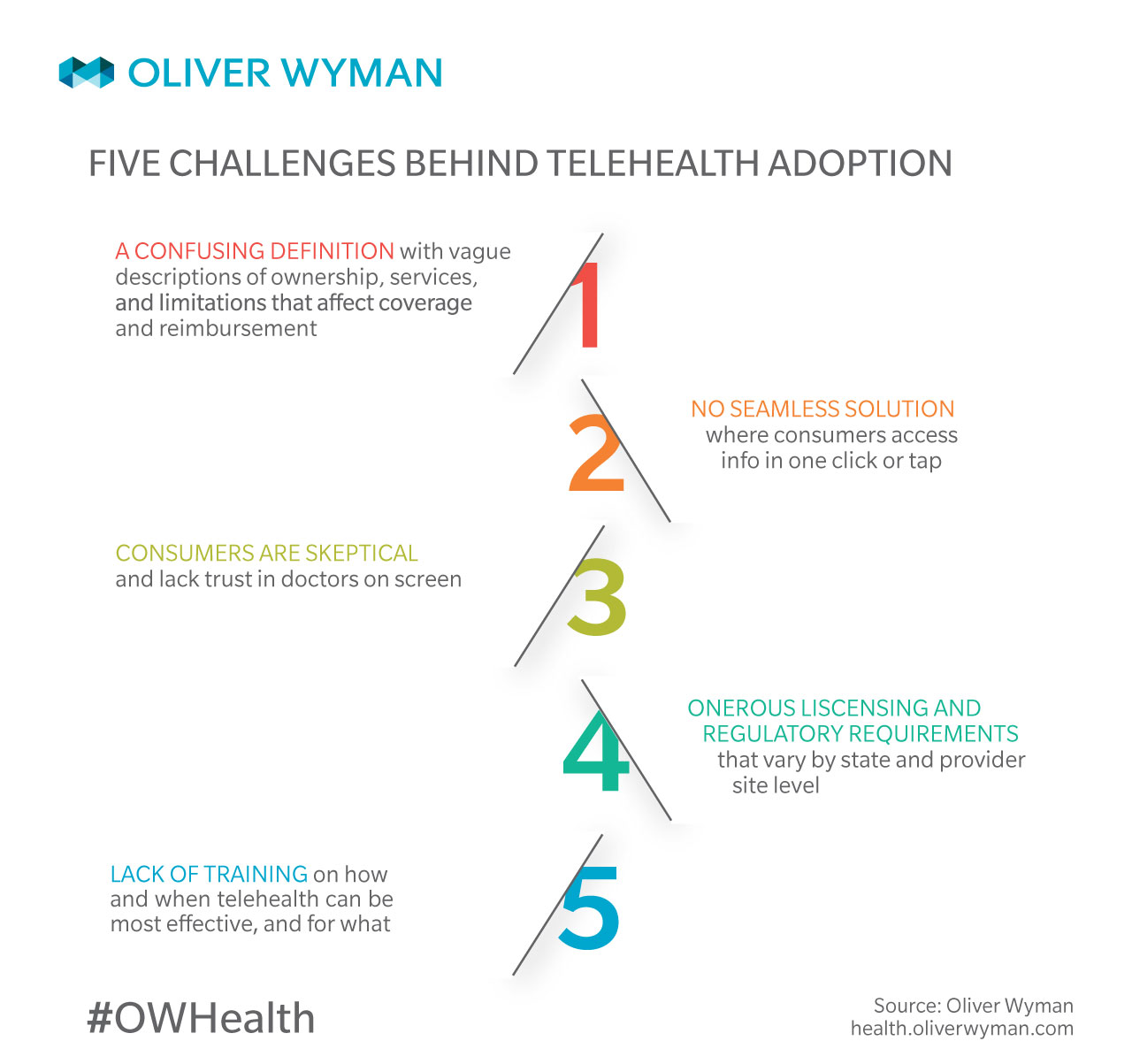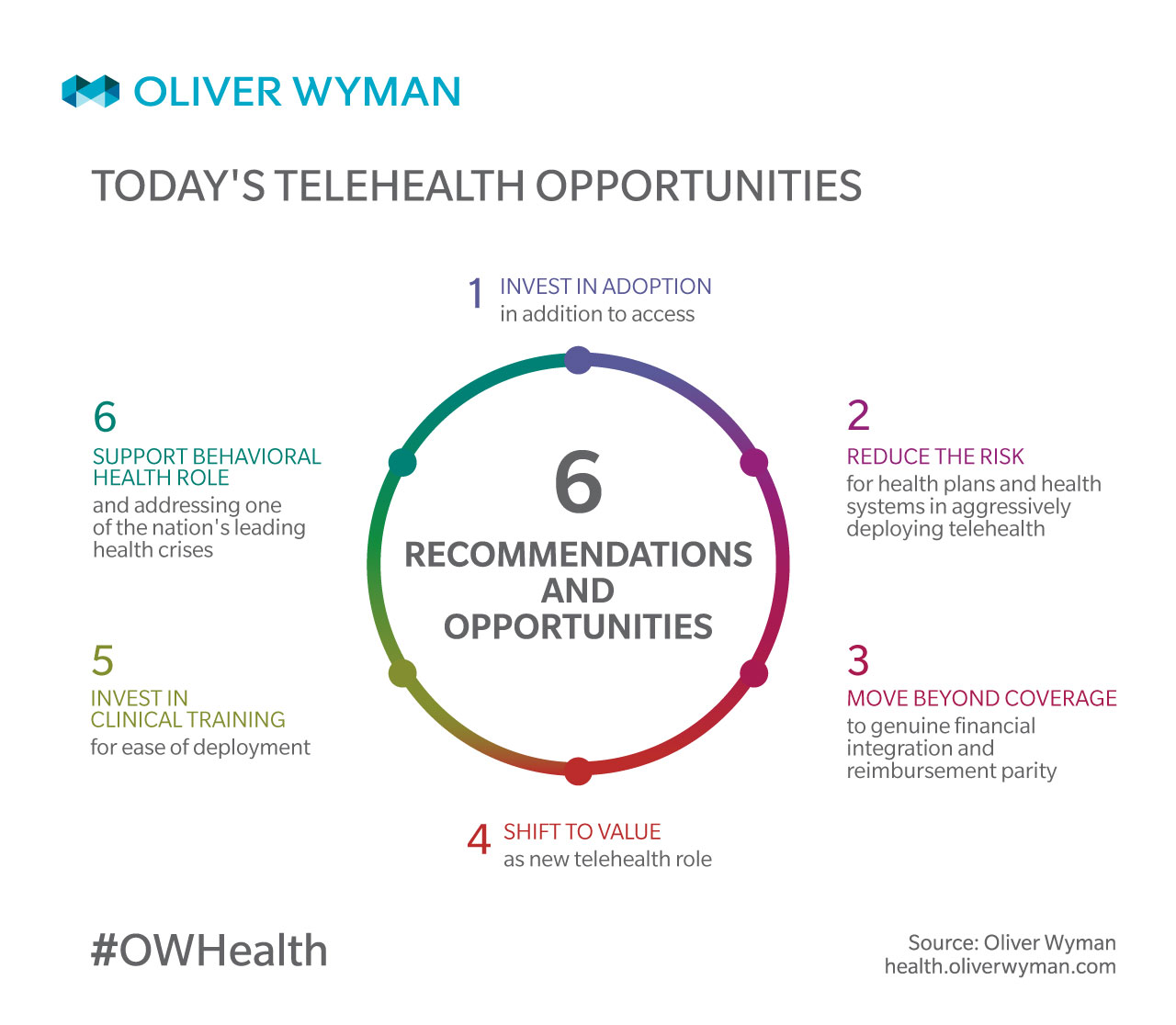The Centers for Medicare & Medicaid Services (CMS) announced a new rule last week that Medicare Advantage (MA) plans will have the option of paying for additional telehealth benefits for at-home patients in 2020. This new rule was released the same week members of Oliver Wyman's Health & Life Sciences practice provided a recommendation for the appropriate role of telehealth in America to the US Congressional Telehealth Caucus. Oliver Wyman's recommendation included an analysis of what it will take to remove barriers for adopting telehealth and similar innovations. Here is a summary of Oliver Wyman's telehealth market analysis.
The Role and Challenges of Telehealth
Telehealth is critical in improving healthcare access, convenience, affordability, and overall care management for Americans as part of US healthcare's broader “new front door” revolution. However, despite a maturing industry and ever-widening access, consumer adoption of telehealth remains low. The reasons behind telehealth adoption challenges are varied, and we believe a multi-faceted approach will address these barriers.
Despite telehealth's promise, the industry still faces challenges:
1. Confusion regarding telehealth's definition: Unfortunately, there's still confusion on what constitutes telehealth. Many healthcare organizations have amorphous definitions of telehealth. Yet others limit it to tele-visits alone. This causes confusion around telehealth ownership and the extent of services offered by each organization, which has a trickle-down effect on coverage and reimbursement.
2. Lack of a seamless solution for consumers, providers and health plans: While new solutions are entering the market, a truly seamless, easy-to-use solution is yet to be designed. Consumers want something simple they can access at the click of a button or tap of an app. Most existing solutions, however, require patients to enter a significant amount of data prior to their first visit, do not share information with other platforms (like provider electronic health record systems), and can be confusing to navigate.
3. Consumer skepticism: Focus groups conducted by Oliver Wyman have demonstrated consumers continue to question telehealth's value. Some don’t trust a doctor on the screen, while others view it as a burdensome extra step in the process (believing that the doctor will just need to see them physically anyway). These attitudes have significantly impacted adoption, which currently hovers at 10 percent. Adoption for Medicare beneficiaries is significantly worse, at less than 0.3 percent.
4. Onerous licensing and regulatory requirements: While significant progress has been made regarding telehealth licensing in recent years, licensing requirements can still vary state-to-state, and many hospitals are required to credential providers on a site-level basis. Given how cumbersome the process can be, some providers shy away from practicing telemedicine, further impacting access and adoption.
5. Lack of training on how to use telehealth: Even if providers have access to telehealth, there is a general lack of training on how and when telehealth can be deployed most effectively, and for what conditions. Care must be taken to ensure telemedicine is being balanced with the human touch that medical care requires to avoid cases where physicians could deliver sensitive news through telehealth channels.
Overcoming these challenges will require a coordinated, consistent effort from all stakeholders within the healthcare system. Support in the form of the right regulations, government grants, and other such federal and state assistance can play an important role in clearing these barriers and putting telehealth on equal footing as a critical area of healthcare innovation.
Six Recommendations for Securing Better Adoption
1. Invest in adoption in addition to access: While many Americans now have access to some form of telehealth, adoption is still low, at 10 percent. These low adoption rates are driven by a variety of factors, including lack of awareness of telehealth options, discomfort with not seeing a doctor in person, and an experience that often requires consumers to download an app, remember their login information, and enter medical history information.
Despite these challenges, our research shows consumers are starting to see telehealth's benefits. In our most recent national survey of consumers, 35 percent of respondents said they would be willing to try telehealth, an increase of 12 percent from when we asked the same question back in 2015. Our research also shows once a consumer has experienced telehealth services for the first time, comfort level grows significantly and there is a much higher willingness and desire to use those services again.
Importantly, consumers will not default to telehealth for everything. There are certain use cases where consumers feel telehealth is a non-starter because it implies a sacrifice in the level or quality of care like, high-acuity conditions.
The development of policies and funding programs that promote innovation in the telehealth experience can help secure adoption. These could take many forms, including innovation challenges, higher federal reimbursement for telehealth services that meet certain requirements for being consumer friendly, or investment in public awareness campaigns regarding telehealth.
2. Reduce the risk for health plans and health systems in aggressively deploying telehealth: Over three-quarters of hospitals are currently using or implementing telehealth, according to the American Hospital Association. This rapid increase in utilization in acute settings is in part attributed to telemedicine’s capacity for improved quality of care, patient outcomes, and cost efficiencies. Despite its advantages, telemedicine comes with liability risks. As telemedicine continues to push new healthcare boundaries at an impressive rate, more and more information emerges about specific legal risks when using virtual care: like privacy, security, patient confidentiality, credentialing, and professional licensure portability. Appropriate policy measures and funding for certification and training programs can help mitigate these liability issues to encourage further adoption of telehealth.
3. Move beyond coverage to genuine financial integration and reimbursement parity: Telehealth presents an opportunity for improved health for all Americans, regardless of their insurance coverage. That said, specific reimbursement and financial integration barriers exist for each payer type, and policy can play a role in eliminating those barriers:
- For Medicare and Medicare Advantage, certain preventative, diagnostic and ongoing disease or chronic condition management should be encouraged and reimbursed accordingly for all consumers, no matter where they live (like in rural settings or MSAs). For appropriate conditions, education and financial incentives within value-based arrangements should be encouraged to help direct consumers to these services. In addition, given the importance of risk adjustment in the Medicare Advantage program, CMS regulations should permit the clinical documentation and coding required for risk adjustment to be conducted based on telehealth visits rather than being restricted to in-person encounters. Similarly, reimbursement should permit Original Medicare beneficiaries to receive telehealth services in the home, rather than having to travel to a doctor’s office.
- For Medicaid, standardization of telehealth benefits across states for select high-cost conditions (like high-risk pregnancies) and associated reimbursement should be accompanied by consumer education and reach into rural areas. In addition, given the role that Federally-Qualified Health Centers (FQHCs) play in providing care for many Medicaid beneficiaries, FQHCs should be permitted to bill for interprofessional Internet consultations that allow them to provide the highest-quality care possible.
- For commercial populations, employers and their healthcare partners (like insurers, wellness companies, and telehealth providers) are largely left on their own to provide incentives for the 180 million consumers covered by their employers to utilize telehealth. Appropriate federal policies could boost these incentives, including premium discounts, tax-advantaged premium rebates, shared savings on cost and outcomes improvements, and other tax-advantaged or financial incentives to employee and employers. Initial virtual preventative consultations should be part of the core benefit stack with no co-pay, co-insurance, or out-of-pocket expenses (for example, not being part of the deductible).
4. Recognize the role telehealth can play in the shift to value: A major shortcoming of our health system today is the predominance of fee-for-service medicine, but the shift to value-based reimbursement is well underway. Telehealth can play a major role in this shift by providing an attractive, low-cost means of managing patients both efficiently and effectively. A well-planned telehealth visit can save clinicians time while still enabling a high-quality patient interaction that allows for management of chronic patients on a more regular basis. Adoption of a virtual model of care for (as an example) a motivated, well-managed diabetic patient could be a positive outcome for both the patient and the provider, encouraging the move away from high-cost, high-volume, transactional medicine. Similarly, the best value-based care involves multi-disciplinary care teams, yet reimbursement for virtual check-ins and remote evaluation often does not apply to non-physician clinicians (like RNs). Through reimbursement, care guidelines, and infrastructure support, public policy should promote telemedicine adoption as providers make the shift to value.
5. Invest in clinician training: A 2017 HIMSS Analytics article posited that 71 percent of healthcare providers use telehealth and telemedicine tools. While this may be true in the most general sense, we would counter that the majority of providers are not making full use of the tools that they have on hand, and that they are not trained on how and when to deploy telehealth–resulting in the recent negative news coverage regarding the delivery of a bleak prognosis via a video monitor. Appropriately training physicians could not only make them more efficient in their use of telehealth and its tools (like utilizing remote physicians to interpret lab results and x-rays), but also help ease both physician fear of liability and consumer discomfort with telehealth. Federal support for telehealth training–both through traditional residency, based training programs and through continuing clinician education, could go a long way towards improving the quality and quantity of care provided via telehealth.
6. Support telehealth’s role in addressing the nation’s behavioral health crisis: Behavioral health conditions lend themselves especially well to care via telehealth channels. Telehealth has proven to be an effective vehicle for care providers to reach and communicate with suffering members, especially in the face of the extreme mental health provider shortage facing the country (more than 60 percent of US counties do not have a single psychiatrist within their borders). Telehealth options also reduce the stigma associated with going in for in-person counseling, and younger adults in particular are comfortable consulting with a behavioral health expert in a telehealth environment. Treating behavioral health conditions can have marked effects on overall healthcare costs, productivity, and employee turnover. Patients with depression, for instance, see their primary care physicians more than five times on average annually, versus fewer than three times for those without depression. For this reason, even though mental health costs appear to account for only 4 percent of claims against employer-sponsored insurance, in reality they represent almost a quarter. Incentives from CMS and employers should be encouraged in this area, as appropriate.


